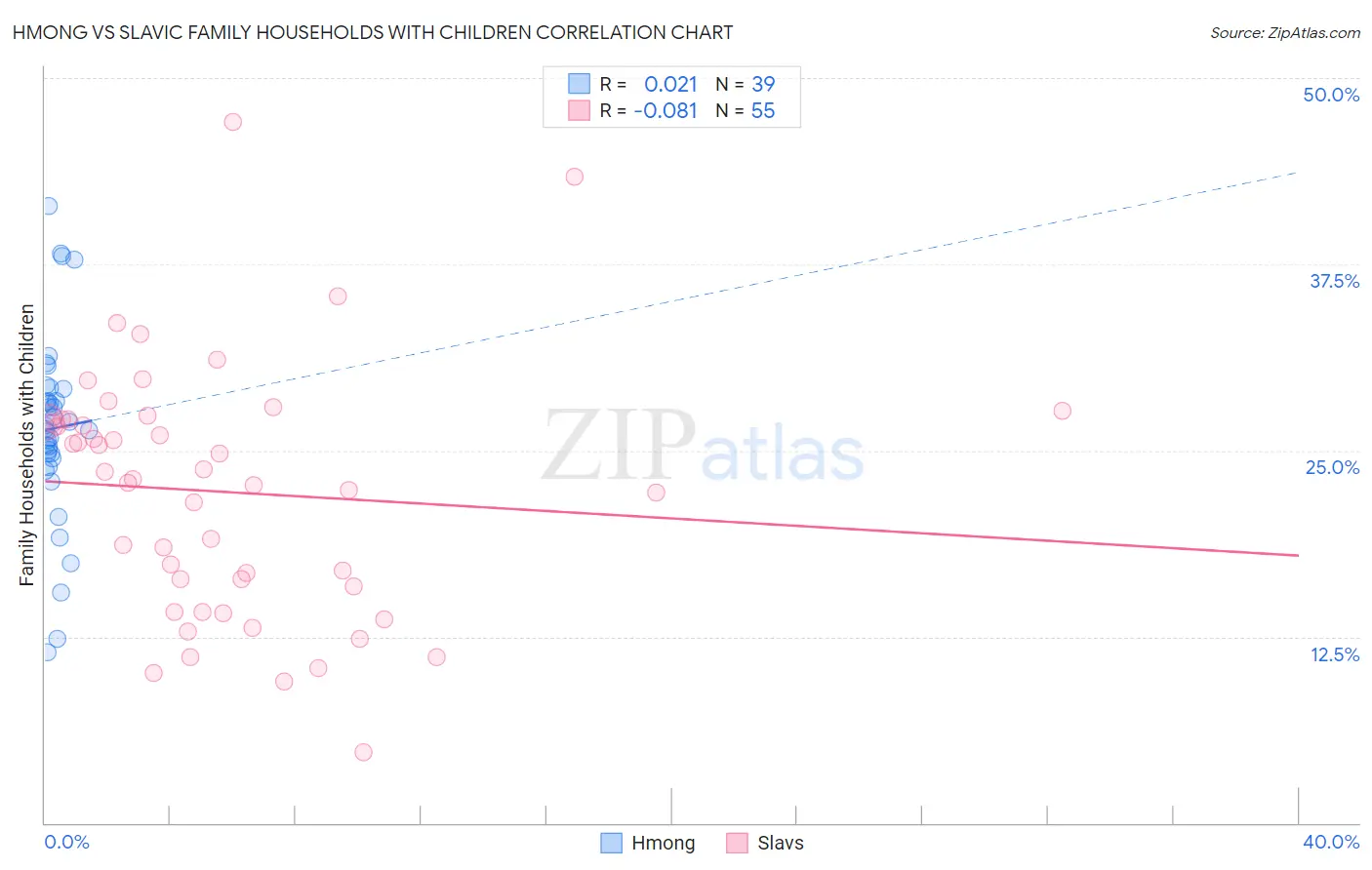Hmong vs Slavic Family Households with Children
COMPARE
Hmong
Slavic
Family Households with Children
Family Households with Children Comparison
Hmong
Slavs
28.6%
FAMILY HOUSEHOLDS WITH CHILDREN
99.9/ 100
METRIC RATING
60th/ 347
METRIC RANK
26.8%
FAMILY HOUSEHOLDS WITH CHILDREN
1.3/ 100
METRIC RATING
257th/ 347
METRIC RANK
Hmong vs Slavic Family Households with Children Correlation Chart
The statistical analysis conducted on geographies consisting of 24,678,157 people shows no correlation between the proportion of Hmong and percentage of family households with children in the United States with a correlation coefficient (R) of 0.021 and weighted average of 28.6%. Similarly, the statistical analysis conducted on geographies consisting of 270,744,912 people shows a slight negative correlation between the proportion of Slavs and percentage of family households with children in the United States with a correlation coefficient (R) of -0.081 and weighted average of 26.8%, a difference of 6.7%.

Family Households with Children Correlation Summary
| Measurement | Hmong | Slavic |
| Minimum | 11.4% | 4.7% |
| Maximum | 41.4% | 47.1% |
| Range | 30.0% | 42.3% |
| Mean | 26.5% | 22.2% |
| Median | 26.4% | 23.1% |
| Interquartile 25% (IQ1) | 24.5% | 15.9% |
| Interquartile 75% (IQ3) | 29.2% | 27.1% |
| Interquartile Range (IQR) | 4.7% | 11.2% |
| Standard Deviation (Sample) | 6.3% | 8.4% |
| Standard Deviation (Population) | 6.2% | 8.3% |
Similar Demographics by Family Households with Children
Demographics Similar to Hmong by Family Households with Children
In terms of family households with children, the demographic groups most similar to Hmong are Immigrants from Nigeria (28.6%, a difference of 0.060%), Immigrants from Ghana (28.6%, a difference of 0.070%), Egyptian (28.6%, a difference of 0.080%), Immigrants from Lebanon (28.6%, a difference of 0.090%), and Filipino (28.6%, a difference of 0.16%).
| Demographics | Rating | Rank | Family Households with Children |
| Immigrants | Cambodia | 100.0 /100 | #53 | Exceptional 28.9% |
| Sierra Leoneans | 100.0 /100 | #54 | Exceptional 28.9% |
| Immigrants | Asia | 100.0 /100 | #55 | Exceptional 28.8% |
| Immigrants | Guatemala | 100.0 /100 | #56 | Exceptional 28.8% |
| Danes | 100.0 /100 | #57 | Exceptional 28.7% |
| Hawaiians | 100.0 /100 | #58 | Exceptional 28.7% |
| Immigrants | Nigeria | 100.0 /100 | #59 | Exceptional 28.6% |
| Hmong | 99.9 /100 | #60 | Exceptional 28.6% |
| Immigrants | Ghana | 99.9 /100 | #61 | Exceptional 28.6% |
| Egyptians | 99.9 /100 | #62 | Exceptional 28.6% |
| Immigrants | Lebanon | 99.9 /100 | #63 | Exceptional 28.6% |
| Filipinos | 99.9 /100 | #64 | Exceptional 28.6% |
| Hondurans | 99.9 /100 | #65 | Exceptional 28.5% |
| Immigrants | Egypt | 99.9 /100 | #66 | Exceptional 28.5% |
| Ghanaians | 99.9 /100 | #67 | Exceptional 28.5% |
Demographics Similar to Slavs by Family Households with Children
In terms of family households with children, the demographic groups most similar to Slavs are Immigrants from Cuba (26.8%, a difference of 0.010%), Immigrants from Lithuania (26.8%, a difference of 0.040%), Scotch-Irish (26.8%, a difference of 0.050%), Immigrants from Jamaica (26.8%, a difference of 0.050%), and German Russian (26.8%, a difference of 0.060%).
| Demographics | Rating | Rank | Family Households with Children |
| Belgians | 2.1 /100 | #250 | Tragic 26.9% |
| Immigrants | Bosnia and Herzegovina | 1.9 /100 | #251 | Tragic 26.8% |
| Irish | 1.8 /100 | #252 | Tragic 26.8% |
| Italians | 1.5 /100 | #253 | Tragic 26.8% |
| Immigrants | Scotland | 1.5 /100 | #254 | Tragic 26.8% |
| German Russians | 1.5 /100 | #255 | Tragic 26.8% |
| Scotch-Irish | 1.4 /100 | #256 | Tragic 26.8% |
| Slavs | 1.3 /100 | #257 | Tragic 26.8% |
| Immigrants | Cuba | 1.3 /100 | #258 | Tragic 26.8% |
| Immigrants | Lithuania | 1.2 /100 | #259 | Tragic 26.8% |
| Immigrants | Jamaica | 1.2 /100 | #260 | Tragic 26.8% |
| Immigrants | Belarus | 1.1 /100 | #261 | Tragic 26.8% |
| Immigrants | Russia | 1.0 /100 | #262 | Tragic 26.8% |
| Immigrants | North Macedonia | 1.0 /100 | #263 | Tragic 26.7% |
| Taiwanese | 0.9 /100 | #264 | Tragic 26.7% |